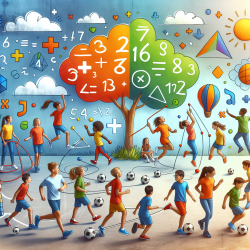In the world of education, innovative teaching methods are constantly being explored to enhance student learning. One such groundbreaking approach is the integration of physical activity (PA) with cognitive tasks, particularly in teaching mathematics. A recent study titled When mathematics meets physical activity in the school-aged child: The effect of an integrated motor and cognitive approach to learning geometry provides compelling evidence on the benefits of this integrated method.
Conducted by Hraste et al. (2018), this study examined the effectiveness of combining motor activities with geometry lessons for fourth-grade students. The results were astonishing: students who participated in the integrated program significantly outperformed those who received traditional instruction. Here’s how you can apply these findings to improve your teaching practice:
Key Findings and Their Implications
- Enhanced Engagement: Integrating physical activities with geometry lessons keeps students engaged and makes learning more enjoyable. Consider incorporating simple physical tasks, such as forming shapes with their bodies or moving to different points in the classroom to solve problems.
- Improved Retention: The study found that students retained mathematical concepts better when they were learned through physical activity. This suggests that incorporating movement can help solidify abstract concepts, making them easier to recall.
- Reduction in Anxiety: Physical activity has been shown to reduce stress and anxiety, which are common barriers to learning math. By making lessons more dynamic and less intimidating, you can create a more positive learning environment.
Practical Tips for Implementation
Here are some practical ways to integrate physical activity into your math lessons:
- Shape Formations: Have students use their bodies to form geometric shapes. This can be done individually or in groups, promoting teamwork and spatial awareness.
- Movement-Based Problem Solving: Set up stations around the classroom where students must solve problems before moving to the next station. This not only incorporates movement but also keeps the lesson dynamic and interactive.
- Interactive Games: Create games that require students to move and think simultaneously. For example, a relay race where students solve a math problem before passing the baton to the next teammate.
Encouraging Further Research
While the results of this study are promising, further research is necessary to explore the long-term benefits and potential applications of this integrated approach. As practitioners, we should be open to experimenting with new methods and sharing our findings with the broader educational community.
To read the original research paper, please follow this link: When mathematics meets physical activity in the school-aged child: The effect of an integrated motor and cognitive approach to learning geometry.










